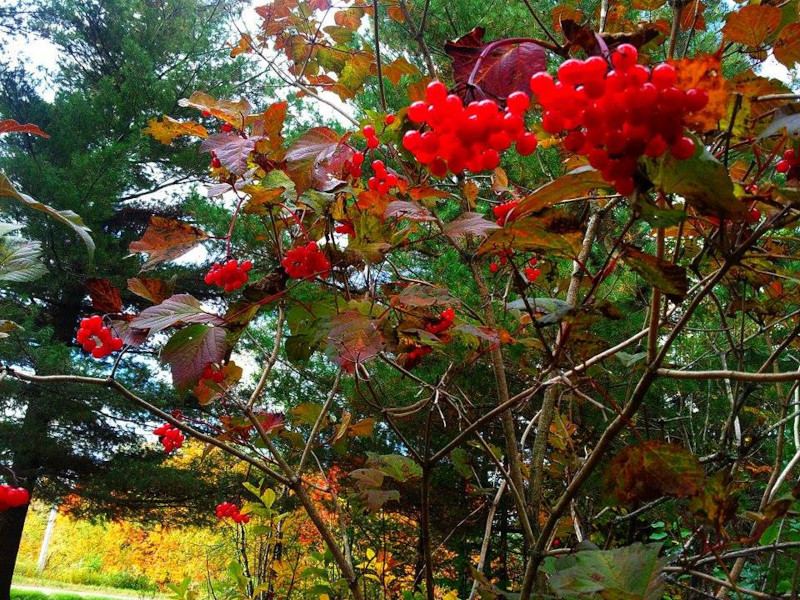American Cranberrybush Facts
- This stunning creation of countless ages of evolution most frequently goes by the informative common name of the American Cranberrybush. It does have other, less often used names, however. That’s a normal situation, though, true for many species.
- These alternate general appellations include the terms highbush cranberry and the similar high bush cranberry, for starters. However, it’s also known to some people in its range as the cranberrybush viburnum. Whichever term one uses, though, it’s gorgeous.
- Professionals, such as researchers, though, generally refer to it by its formal, technical name. That’s the somewhat difficult to pronounce term of the Viburnum trilobum. It also bears an extremely close relationship to similar species in other parts of the world.
- The Angiosperm further received the technical name at the hands of the American botanist Humphrey Marshall. The noted researcher and plant dealer accomplished the first recorded official recognition of the plant as a separate and distinct species.
- For the moment, the American Cranberrybush appears to be maintaining a population base that’s both sizeable and sufficient. This fact also seems to hold true throughout the entirety of its range. The IUCN, therefore, has no listing for it on its Red List.
- The natural wonder must be considered to be facing at least some threats to its existence, however. That’s because most species now do. Habitat loss, due to human expansion, poses a threat. Its greatest danger, though, comes from climate change.
Related Articles
American Cranberrybush Physical Description
The gorgeous American Cranberrybush easily impresses those fortunate enough to encounter it. It does so, though, for several reasons. While sheer physical size isn’t its only appeal, this characteristic of the plant nevertheless does merit a certain level of appreciation.
The flora evolved as an excellent example of a deciduous shrub. In this category, however, it ranks as an above average sized member. That’s due to the fact that individual specimens attain heights of as much as 13 ft (4 m). Most, though, remain slightly smaller in size.
The natural construction of this particular flora further enhances its distinctiveness. The bark of the shrub develops as relatively rough, with a somewhat scaly texture. This aspect of the amazing Angiosperm also presents a gray color, that varies from light to dark.
Its stems also arch sharply vertically, and develop as quite densely packed. The short, thin twigs that branch off of these typically manifest a reddish-brown hue. These it also tends to produce in copious quantities, making for yet another relatively dense structure.
Its foliage, meanwhile, usually develops opposite, and three-lobed in structure. These develop as moderate-sized, though. Each averages 2.25 – 4.75 in (6-12 cm) in length, and 2-4 in (5-10 cm) in width. Their shape actually remains very similar to maple leaves.
The stuning flowers of the American Cranberrybush also stand out. These present a brilliant white shade, and generally appear in groupings up to 5 in (13 cm) in diameter. The fruit develops as small, with an oblong shape. Each averages 0.6 in (1.5 cm) by 0.5 in (1.2 cm).
- Kingdom: Plantae
- Phylum: Angiosperms
- Class: Eudicots
- Order: Dipsacales
- Family: Adoxaceae
- Genus: Viburnum
- Species: V. trilobum
American Cranberrybush Distribution, Habitat, and Ecology
The remarkable American Cranberrybush evolved as native to a region of the globe well known for its abundance of natural beauty. That’s due to the fact that it developed in the portion of the earth that now forms the continent known as North America.
As its very name indicates, the majority of the zone of native habitation consists of part of the United States. There, though, it only lives in the far northern sections, from coast to coast. The great majority of its population, however, appears in the northeast.
Yet its habitat range also extends into the extreme southeast sections of Canada. Outside of these two areas, a handful of small, thinly populated concentrations also appear elsewhere in both countries. Its presently unknown if this is a natural occurrence, though.
Within these areas, however, it seems to be highly adaptible in its habitat requirements. Due to this, it makes its home in a wide variety of regions. These include such diverse ecosystems as sandy swamps, moist woodlands, forested bogs, and even roadside ditches.
Like most of its kindred, the American Cranberrybush achieves pollination via the actions of various local insects. Mosts specimens produce fruit after 5-6 years. At that time, numerous animals consume the fruits, especially birds, thereafter spreading the seeds via droppings.
Despite its name, however, it’s not actually a variety of cranberry at all. The name derives from the strong resemblance of its fruit to true cranberries. Though rather sour to human taste, the fruits are fully edible, and contain high amounts of several types of vitamins.
Species Sharing Its Range
Check out our other articles on 5 Fully Fabulous Frogs, African Monarch, Laguna Verde, Blainville’s Beaked Whale, Smooth Purple Coneflower, Nicobar Pigeon, Yellow-Bellied Sea Snake

